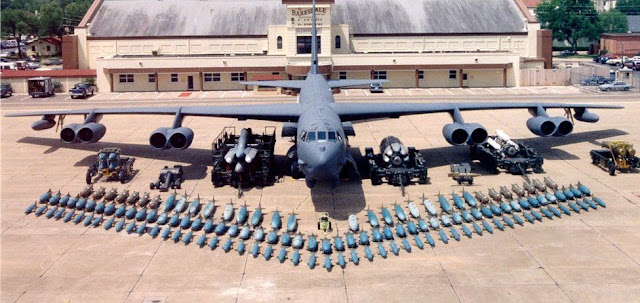Air Force plans to update the B52 for use throughout most of the 21st century by adding defensive lasers
by noreply@blogger.com (brian wang) from NextBigFuture.com on (#2BZJ6)
Offensive and defensive laser weapons for Air Force fighter jets and large cargo aircraft have been in development for several years now. However, the Air Force Research Lab (AFRL) has recently embarked upon a special five-year effort, called the SHIELD program, aimed at creating sufficient on-board power, optics and high-energy lasers able to defend large platforms such as a B-52 bomber.
Possibly using an externally-mounted POD with sufficient transportable electrical power, the AFRL is already working on experimental demonstrator weapons able to bolt-on to an aircraft, AFRL Chief Scientist Zacharias added.
Given that an external POD would add shapes to the fuselage which would make an aircraft likely to be vulnerable to enemy air defense radar systems, the bolt-on defensive laser would not be expected to work on a stealthy platform, he explained.
However, a heavily armed B-52, as a large 1960s-era target, would perhaps best benefit from an ability to defend itself from the air; such a technology would indeed be relevant and potentially useful to the Air Force, as the service is now immersed in a series of high-tech upgrades for the B-52 so that it can continue to serve for decades to come.
Defending a B-52 could becoming increasing important in years to come if some kind of reconfigured B-52 is used as the Pentagon's emerging Arsenal Plane or "flying bomb truck."

Read more










Possibly using an externally-mounted POD with sufficient transportable electrical power, the AFRL is already working on experimental demonstrator weapons able to bolt-on to an aircraft, AFRL Chief Scientist Zacharias added.
Given that an external POD would add shapes to the fuselage which would make an aircraft likely to be vulnerable to enemy air defense radar systems, the bolt-on defensive laser would not be expected to work on a stealthy platform, he explained.
However, a heavily armed B-52, as a large 1960s-era target, would perhaps best benefit from an ability to defend itself from the air; such a technology would indeed be relevant and potentially useful to the Air Force, as the service is now immersed in a series of high-tech upgrades for the B-52 so that it can continue to serve for decades to come.
Defending a B-52 could becoming increasing important in years to come if some kind of reconfigured B-52 is used as the Pentagon's emerging Arsenal Plane or "flying bomb truck."

Read more